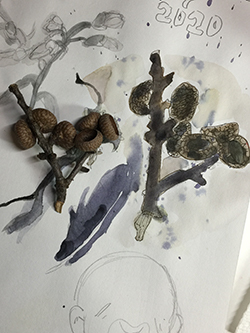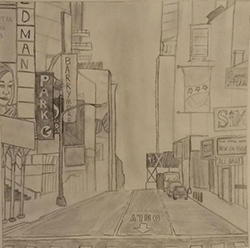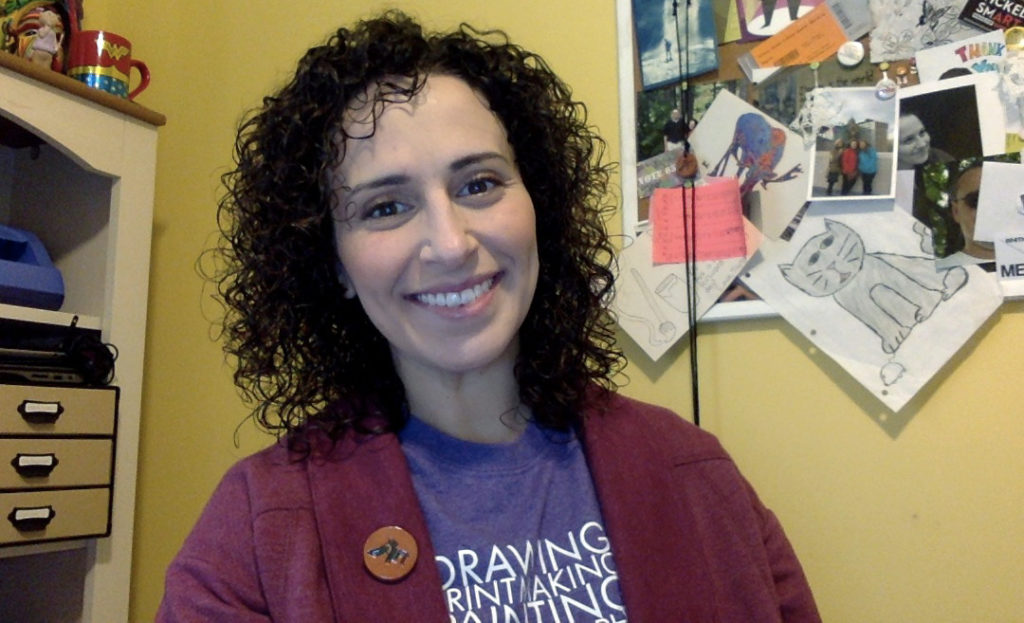Byron Center West Middle School eighth grader Rachel Okhuysen used sketch paper and graphite pencils to draw New York City’s Broadway theater district. Her piece shows a quiet street, absent of its illuminated hustle and bustle and musical fanfare.
“This was based on a picture of the street during the COVID-19 pandemic, which resulted in it being empty of life,” Rachel wrote in her artist’s statement. “I used the greys to convey that as there is no color of excitement to the empty street.”
Rachel, who loves theater, said she wanted to illustrate a place known to be filled with action and emotion and convey its current stillness. “It feels empty and dead, almost,” she said, adding that she feels the quiet and isolation of being home and away from school.
“Everyone around us is being affected by COVID 19.”
Educators –now tasked with bringing their students’ instruction online– are posting history and math lessons, writing and reading assignments, offering the classroom learning they would be leading, now from a distance.
But art teachers’ work is a bit different. They are asking students to use the time when school is closed due to the coronavirus outbreak as an opportunity to reflect, expand boundaries, use the environment and create art out of just about anything.
“For me personally, art has helped give me an outlet and keep me busy physically and emotionally. It’s taxing being alone in your house being cooped up and having no outlet. Art is a very good way to let those emotions out.”
— East Kentwood High School sophomore Jasmine Arechiga-Jacobo
After all, in troubled times, people turn to the artists for messages of hope, love, faith, fear and loss, said West Middle School teacher Janine Campbell. People are realizing the power of art in healing and sharing: from the chalk art, window signs and decorated masks being created all over the world.
Rachel’s piece was created as part of Campbell’s thematic unit “space and place,” for which students had the choice to create art based on environments: places they have been, would like to go, or that have had an impact on them in some way.
Campbell has noticed how students’ pieces are reflecting the pandemic and their feelings about it. “It’s definitely a reflection of what they are going through,” she said.
Rachel agreed. Using art as an outlet helps. “I think that being able to draw your ideals right now is very important… Being able to draw your emotions and connect with places you would like to go is very important.”

The World of Art Around Us
Wyoming High School art teachers Elizabeth Duffield and Robyn Gransow-Higley are assigning six weeks of art lessons through Google Classroom including photographed self-portraits reflecting students’ emotions and a photography essay on “what happiness is to me”.
“What are the different feelings you are experiencing through this pandemic? How can you show those feelings through photography?” Duffield said.
Teachers also know many students’ art supply stash is limited, so they are challenging them to gather items outside and around the house. Wyoming students are making color wheels with household items and an “earthwork” with things like rocks, acorns or bark.
“I think the one thing I have found and the students have responded to in their projects and said is they have a real appreciation in just looking at the world in a different way right now,” Duffield said. “They are feeling connected by making things and going out in nature and having a better appreciation of nature and making projects.”
“We are already having kids saying they are enjoying what they are doing,” Gransow-Higley said. “As we get deeper in I think they will be able to see the relevance in why we are asking them to do this. It’s not something you do and get done. It might be something that changes the way they are looking at their environment forever.”
East Kentwood High School art teacher Le Tran encouraged students to use whatever materials they can find at home to create surrealistic artwork and use the pandemic to express their feelings.
Sophomore Jasmine Arechiga-Jacobo used digital images and editing to create her imaginative collage, which merges motion and technology. She said she loves to use art as a means of expression.
“For me personally, art has helped give me an outlet and keep me busy physically and emotionally. It’s taxing being alone in your house being cooped up and having no outlet. Art is a very good way to let those emotions out.”

Blending Art & Technology
A new reality of art lessons during the pandemic is the resource savviness required to make it work, technologically and material-wise. Students are sketching, painting and molding, sending photos of creations to their teachers who post them on virtual sites. Many of the tools they are using to create come from within students’ homes.
Tran, who knows many of her students lack paints and brushes, tells her students to use magazine art, junk mail, even kitchen spices and food coloring.
“Your kitchens have cabinets full of art supplies,” she tells them. She’s encouraged them to make pigment with food coloring and use beets, onion skin, coffee and tea stains for painting. She hopes they can find some kind of paintbrush. “They are going to be scientists in the kitchen,” she said.
She’s also advising them to be explorers now more than ever. Find materials in the yard and buried in drawers, she tells them. Search for information online.
Tran has had to transition from her usual teaching technique, which involves lots of demonstrations and observations – “them watching me and me watching them”— to virtual teaching. Her classroom wasn’t equipped with a lot of technology, so teaching remotely involves a learning curve. She sees the need, more than ever now, to always have a blended learning environment, a mix of virtual and hands-on instruction.
“It really is a necessity to be a 21st century learner,” Tran said. “There are so many online resources. It’s a goldmine out there.”
When it comes to resourcefulness, Northview art teachers have gotten their students and “kids” involved. Highlights include a collage challenge by September Buys, and Tricia Erickson has even gotten her pet goats involved in a lesson.
Northview teachers have been posting daily activities and challenges to the district’s visual arts page on Facebook, and updating its K-12 visual arts webpage with much of the same information.

What’s Possible Online?
At West Middle School, Campbell’s students continued instruction fairly seamlessly. Her classroom has been well equipped with technology since 2008, when she began incorporating it into her teaching thanks to a cart of computers. Her students regularly use iPads, digital photography and editing tools.
“The access to technology I’ve been fortunate to have is definitely paying off now.”
Campbell helps other teachers learn to incorporate technology in art. In March she was named the Michigan Association for Computer Users in Learning innovative teacher of the year.
She’s used online tutorials and collected student art on artsonia for years. She can give direct feedback to students on that platform. She does a Monday conference call with students on schoology. She’s also recording herself while she teaches.
“One thing really cool is the amount of sharing going on with teachers online,” she said.
Still, she misses the classroom, the conversations, the interactions, the messiness of creating together. “The thing I miss the most is the daily interaction,” Campbell said. “If they are creating art in front of me, I can give them real-time feedback.”
“The magic happens in the process, so I am missing that magic. But I love seeing that they are still trying.”
School News Network Reporter Morgan Jarema contributed to this article.









